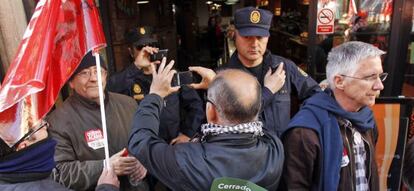Streams of social justice
Protesters are making the most of new technologies, such as live video feeds of demonstrations, to help get their message across and gain support

They are the eyes, ears and voice of the people who cannot be there physically at a street protest or preventing the latest home eviction. They are better known through their Twitter accounts than by their real names. They are activists who have turned live online streaming into a weapon "for revolution."
The use of streamcasts as a form of protest became popular in Spain with the grassroots movement known as 15-M, or the "Indignados." From there it extended to other types of social demands, and these days it is common to find one or several activists holding a mobile phone or tablet to broadcast the protest as it happens.
The number of streamers depends on the event. At a sit-in before Congress there might be over a dozen, while one or two will do for a home eviction, according to the activists Stéphane Grueso (@fanetin), Alicia Arnesto (@alitwittt), and @suysulucha, who asked that only her first name, Susana, be used. They are all Spaniards in their forties, and the most popular streamers of all. Grueso explains that there are about eight regulars who cover all manner of events, with a growing number of apprentices and spontaneous streamers popping up here and there. Grueso is easy to spot at protests because he can be seen holding up a tablet protected by a neon green cover with side handles to improve image stability. Susana, who uses a smartphone, says that it is hard to be constant at this sort of activism. "People work on impulse. You can tell when there is social excitement over something like 15-M," she adds.
There is a widespread belief that just about anyone can do this. "That's only a half-truth, since certain technical aspects have to be met, such as a good internet connection, several additional batteries and knowledge about the best transmission service," says Susana.
The police take notice of us. If there is violence, it's going to get publicized"
Alicia Arnesto recommends always carrying around a hotspot (a portable device for connecting to the internet) to improve quality. "With a signal under 512 kilobytes you might as well not even try," she says.
As for batteries, for a march or sit-in it will be necessary to lug around at least five or six, says Grueso.
The live images may be seen on various sites such as Livestream, Ustream and Bambuser, which are all very similar. During the event proper, comments can be made via Twitter, Facebook or one's own chat channel. Bambuser is the most popular site in Spain because it provides a better quality service to users with journalist credentials. During the Arab Spring it became so popular that the Associated Press ended up investing in it.
The audience typically ranges from 3,000 to 5,000 followers. If it's a protest where there's sure to be violence, this figure shoots up to over 60,000 people, according to Arnesto. In order to increase circulation they share their streamcast with other websites such as the alternative channels Tomalatele or Peoplewitness, which specialize in news with a political and social slant.
During the streamcast, the relationship between streamer and audience is constant through the social networks. "They even bring me sandwiches, batteries, telephones and water to wherever I'm streaming from, when they hear me say that I need something," says Susana.
Although it is part entertainment, part public service, this activity has its difficulties. Confrontations with the police are common. "Police officers take notice of us. If there is violence, it's going to get publicized. During a streamcast you are the cameraman, the host and the commentator all at the same time. They don't quite get it and they try to move us on," says Arnesto. To bypass this problem, Susana is going to use her pet Kiko as a "camera dog" by installing a camera on his back. "I can't wait to see them try to arrest him."
Tu suscripción se está usando en otro dispositivo
¿Quieres añadir otro usuario a tu suscripción?
Si continúas leyendo en este dispositivo, no se podrá leer en el otro.
FlechaTu suscripción se está usando en otro dispositivo y solo puedes acceder a EL PAÍS desde un dispositivo a la vez.
Si quieres compartir tu cuenta, cambia tu suscripción a la modalidad Premium, así podrás añadir otro usuario. Cada uno accederá con su propia cuenta de email, lo que os permitirá personalizar vuestra experiencia en EL PAÍS.
¿Tienes una suscripción de empresa? Accede aquí para contratar más cuentas.
En el caso de no saber quién está usando tu cuenta, te recomendamos cambiar tu contraseña aquí.
Si decides continuar compartiendo tu cuenta, este mensaje se mostrará en tu dispositivo y en el de la otra persona que está usando tu cuenta de forma indefinida, afectando a tu experiencia de lectura. Puedes consultar aquí los términos y condiciones de la suscripción digital.
Últimas noticias
Mexico seeks to shore up its defenses following US incursion in Venezuela
Hope gives way to uncertainty among Venezuelan exiles in the US after Maduro’s capture
Cubans look to Venezuela fearfully after Trump’s incursion: ‘We could be next’
The operation in Venezuela to capture Maduro threatens to widen the cracks in the MAGA movement
Most viewed
- Alain Aspect, Nobel laureate in physics: ‘Einstein was so smart that he would have had to recognize quantum entanglement’
- Alvin Hellerstein, a 92-year-old judge appointed by Bill Clinton, to preside over Maduro’s trial in New York
- Gilles Lipovetsky: ‘If you want to live better and fall in love, take Prozac, don’t look to philosophy’
- Cuba confirms death of 32 of its citizens in the US attack against Venezuela
- Why oil has been at the center of Venezuela-US conflicts for decades








































